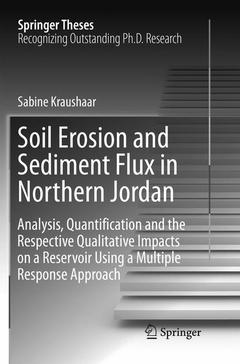Soil Erosion and Sediment Flux in Northern Jordan, Softcover reprint of the original 1st ed. 2016 Analysis, Quantification and the Respective Qualitative Impacts on a Reservoir Using a Multiple Response Approach Springer Theses Series
Auteur : Kraushaar Sabine

2. The Wadi Al-Arab
3. Erosion Features and Measurement Methods on the Slope
4. Qualitative Effects of Sediments on the Wadi Al-Arab Reservoir
5. Sediment Fingerprinting: A Revised Approach for Data Correction and Evaluation
6. Wrapping Up Findings in a Sediment Transport Model for Wadi Al-Arab
7. Final Conclusion and Discussion of the Results
8. Outlook
9. Innovative Aspects of the Research
Appendices
Nominated as an outstanding Ph.D. thesis by Dr Thomas Glade, Institute of Geography and Regional Research, University of Vienna, Austria
A multiple response approach combining new measurement methods with a geochemical fingerprint and a model approach
Significant development of the sediment fingerprint method, a method that is at the forefront of science and at the interface between soil science, geomorphology and hydrology
Presents new methods to estimate long term average soil erosion rates, using olive mounds and roman cistern sediments
One of the first integrated studies on recent soil erosion in an exemplary catchment in Jordan with important information for policy-makers and resource authorities when planning actions to deal with soil loss and increasing sedimentation in reservoirs
Includes supplementary material: sn.pub/extras
Date de parution : 05-2018
Ouvrage de 185 p.
15.5x23.5 cm
Disponible chez l'éditeur (délai d'approvisionnement : 15 jours).
Prix indicatif 105,49 €
Ajouter au panierDate de parution : 05-2016
Ouvrage de 185 p.
15.5x23.5 cm
Disponible chez l'éditeur (délai d'approvisionnement : 15 jours).
Prix indicatif 105,49 €
Ajouter au panier


